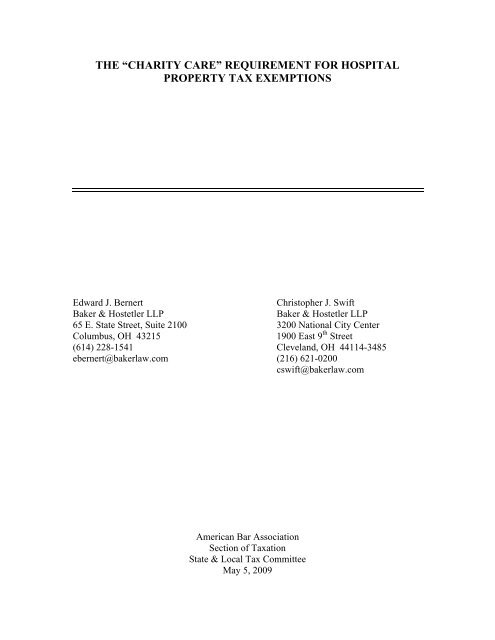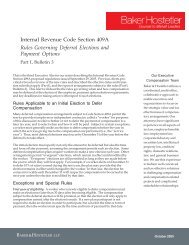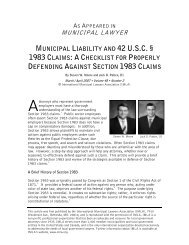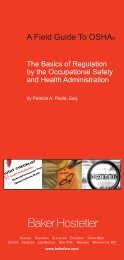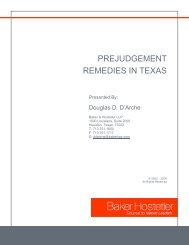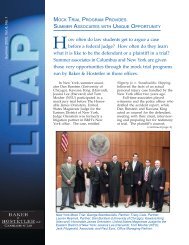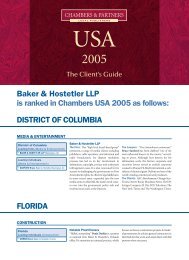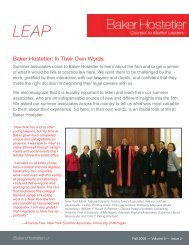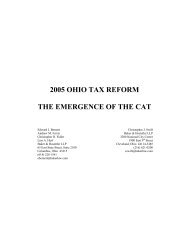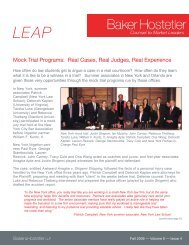The Charity Care Requirement for Hospital Property Tax Exemptions
The Charity Care Requirement for Hospital Property Tax Exemptions
The Charity Care Requirement for Hospital Property Tax Exemptions
Create successful ePaper yourself
Turn your PDF publications into a flip-book with our unique Google optimized e-Paper software.
THE “CHARITY CARE” REQUIREMENT FOR HOSPITAL<br />
PROPERTY TAX EXEMPTIONS<br />
Edward J. Bernert<br />
Christopher J. Swift<br />
Baker & Hostetler LLP<br />
Baker & Hostetler LLP<br />
65 E. State Street, Suite 2100 3200 National City Center<br />
Columbus, OH 43215<br />
1900 East 9 th Street<br />
(614) 228-1541 Cleveland, OH 44114-3485<br />
ebernert@bakerlaw.com (216) 621-0200<br />
cswift@bakerlaw.com<br />
American Bar Association<br />
Section of <strong>Tax</strong>ation<br />
State & Local <strong>Tax</strong> Committee<br />
May 5, 2009
THE “CHARITY CARE” REQUIREMENT FOR HOSPITAL PROPERTY<br />
TAX EXEMPTIONS<br />
Edward J. Bernert<br />
Christopher J. Swift<br />
I. Introduction<br />
<strong>Hospital</strong>s throughout the United States are accorded the benefits of a charitable<br />
exemption from various state and local ad valorem property taxes. <strong>The</strong> issue we examine<br />
is the role of a “charity care” requirement, meaning a certain level of “free or discounted<br />
medical care” as a condition to hospitals obtaining charitable exemptions from property<br />
taxes.<br />
A case pending be<strong>for</strong>e the Illinois Supreme Court has attracted considerable<br />
attention because it presents a high profile opportunity <strong>for</strong> that Court to decide whether a<br />
quantified level of charity care is the sine qua non of the charity exemption in Illinois,<br />
Provena Covenant Medical Center v. Illinois Department of Revenue, 384 Ill. App. 3d<br />
734, 894 N.E. 2d 452 (4 th Dist. August 26, 2008), cert. granted, Illinois Supreme Court,<br />
Case No. 107328. <strong>The</strong> appellate court in Provena upheld the Director of the Illinois<br />
Department of Revenue (Director) and denied an exemption in large measure because of<br />
an inadequate demonstration of a level of free care.<br />
A recent decision by the Connecticut Supreme Court--St. Joseph’s Living Center,<br />
Inc. v. Town of Windham, 240 Conn. 695 (March 24, 2009)--while denying the<br />
exemption in that case, nevertheless chose to reject arguments that were successfully<br />
advanced in Provena. <strong>The</strong> Connecticut Supreme Court followed the line of cases from<br />
other states that focus on the overall charitable nature of the health care institution in<br />
contrast to limiting the analysis to specific activities, such as free care <strong>for</strong> the poor, in<br />
gauging qualification <strong>for</strong> exemption.<br />
<strong>The</strong>se two cases, and the decisions of other state supreme courts, provide useful<br />
vehicles to address the role of quantified charity care in the granting to hospitals of<br />
charitable exemptions from property taxes. This issue has been addressed in a number of<br />
decisions but remains a subject of dispute, including in Ohio, in which the issue is being<br />
litigated at the Ohio Board of <strong>Tax</strong> Appeals.<br />
<strong>The</strong> issue is one of state not federal law. State charitable property tax exemptions<br />
are not assured <strong>for</strong> owners that qualify <strong>for</strong> federal income tax exemption under Internal<br />
Revenue Code §501(c)(3). While the state and local property tax exemptions do not<br />
depend on qualification under federal law, the policies under the Internal Revenue Code<br />
likely will impact the manner in which the state exemptions are examined.<br />
A reexamination of the federal income tax exemption of hospitals is under way.<br />
Beginning with the 2008 and 2009 returns, the Federal Form 990, Return of Organization<br />
2
Exemption from Income <strong>Tax</strong>, has expanded the disclosure requirements applicable to<br />
hospitals claiming income tax exemption, including a reporting of the hospital’s charity<br />
care policies in new Schedule H. Also, United States Senator Charles Grassley of Iowa<br />
has focused his ef<strong>for</strong>ts on the charitable exemption <strong>for</strong> the federal income tax available to<br />
hospitals and has vowed to change the manner in which the income tax exemption is<br />
administered.<br />
This report will not address the federal income tax law. Instead, we (1) examine<br />
the Illinois appellate court decision in Provena and the issues relevant to the availability<br />
of the charitable exemption to Provena likely to be addressed by the Illinois Supreme<br />
Court, 1 (2) compare that Illinois appellate decision with the St. Joseph’s case in<br />
Connecticut and several decisions of other state supreme courts that have addressed the<br />
charitable exemption <strong>for</strong> hospitals, and (3) examine tax statutes in Pennsylvania and<br />
Texas that address the charity care issue legislatively.<br />
II.<br />
Illinois--<strong>The</strong> Provena Case<br />
A. Introduction<br />
Provena <strong>Hospital</strong>s (Provena) is a nonprofit, full service general acute-care<br />
hospital located in Champaign County, Illinois. <strong>The</strong> owner of the hospital qualified<br />
under IRC §501(c)(3) <strong>for</strong> a charitable exemption and qualified <strong>for</strong> exemption from the<br />
Illinois sales and use taxes as a charity. Provena sought property tax exemption from the<br />
Champaign County Board of Review, which denied the exemption. Provena appealed the<br />
decision and the Administrative Law Judge (ALJ) assigned to the appeal recommended<br />
exemption on the basis that Provena was a charitable institution and its property was used<br />
primarily <strong>for</strong> charitable purposes. <strong>The</strong> Director disagreed with the recommendation of<br />
the ALJ. <strong>The</strong> appellate court in Provena described the actions of the Director in the<br />
following terms:<br />
<strong>The</strong> Director disagreed with the ALJ's recommendation and<br />
denied an exemption <strong>for</strong> charitable uses. <strong>The</strong> primary<br />
reason <strong>for</strong> his decision was that in 2002, the tax year in<br />
question, [Provena] devoted only 0.7% of its total revenue<br />
to charity care. Of 110,000 admissions in 2002, [Provena]<br />
gave free care to only 196 patients and discounted care to<br />
only 106 patients; and [Provena] hired collection agencies<br />
to recover the remaining balances from 64 of the patients to<br />
whom it had given discounts.<br />
Provena challenged the decision of the Director in an administrative review to the circuit<br />
court, and advanced the following argument:<br />
…under the [Illinois] supreme court's decisions, charities<br />
were not defined by percentages and that, in any event,<br />
1 We will not address the religious use exemption issue also raised in the Provena appeal.<br />
3
[Provena] dispensed an ample amount of charity to the<br />
community in <strong>for</strong>ms other than charity care. [Provena] had<br />
a charity-care policy based on federal poverty guidelines,<br />
and it advertised the availability of "financial assistance."<br />
According to Provena, [it] gave this financial assistance to<br />
every patient who needed and requested it, and the number<br />
of indigent people who walked in through the door and<br />
availed themselves of the charity-care policy simply was<br />
beyond [Provena’s] control. Also, Provena argued,<br />
considering the meager rates of reimbursement the<br />
government paid, treating Medicare and Medicaid patients<br />
was itself an act of charity. Provena further argued--indeed,<br />
the parties had stipulated--that [Provena] was a faith-based<br />
institution founded, organized, owned, and operated as an<br />
apostolic mission and health-care ministry of the Catholic<br />
Church.<br />
<strong>The</strong> circuit court found in favor of Provena. <strong>The</strong> Director appealed, and as noted,<br />
the appellate court denied the exemption. <strong>The</strong> Illinois Supreme Court has accepted the<br />
case <strong>for</strong> appeal. At this writing, the matter is being briefed and oral argument has not yet<br />
been scheduled.<br />
B. <strong>The</strong> Illinois Law<br />
Ill. Const. 1970, art. IX, §6. It provides:<br />
"<strong>The</strong> General Assembly by law may exempt from taxation<br />
only the property of the [s]tate, units of local government<br />
and school districts[,] and property used exclusively <strong>for</strong><br />
agricultural and horticultural societies[] and <strong>for</strong> school,<br />
religious, cemetery[,] and charitable purposes. <strong>The</strong> General<br />
Assembly by law may grant homestead exemptions or rent<br />
credits." Ill. Const. 1970, art. IX, §6.<br />
<strong>The</strong> Illinois statute, 35 ILCS 200/15-65(a) (West 2002)<br />
provides:<br />
"All property of the following is exempt when actually and<br />
exclusively used <strong>for</strong> charitable or beneficent purposes[] and<br />
not leased or otherwise used with a view to profit:<br />
(a) Institutions of public charity."<br />
In Methodist Old Peoples Home v. Korzen, 39 Ill. 2d 149, 157, 233 N.E.2d 537,<br />
541-42 (1968), the Illinois Supreme Court listed six "distinctive characteristics of a<br />
charitable institution:"<br />
4
(1) the institution bestows benefits upon an indefinite number of persons<br />
<strong>for</strong> their general welfare, or the benefits in some way reduce the burdens<br />
on government;<br />
(2) the institution has no capital, capital stock, or shareholders and does<br />
not profit from the enterprise;<br />
(3) the funds of the institution are derived mainly from private and public<br />
charity and are held in trust <strong>for</strong> the purposes expressed in the charter;<br />
(4) charity is dispensed to all who need it and apply <strong>for</strong> it;<br />
(5) the institution puts no obstacles in the way of those seeking the<br />
charitable benefits; and<br />
(6) the primary use of the property is <strong>for</strong> charitable purposes.<br />
From the above, it may be concluded that providing care <strong>for</strong> the sick is not per se<br />
a charitable activity. Further, maintaining nonprofit status is required but not sufficient.<br />
<strong>The</strong> appellate court examined whether Provena was providing a benefit to the<br />
public and thereby alleviating a burden on government. <strong>The</strong> court found an absence of<br />
public benefit in that Provena was selling medical services.<br />
<strong>The</strong> record was unclear as to the extent to which Provena was financed by<br />
voluntary contributions. <strong>The</strong> court acknowledged that modern hospitals do not receive<br />
many, if any, private contributions. Provena responded that providing medical care is a<br />
charitable purpose and Provena focused its argument on the charitable aspect of the<br />
original gift that supported founding the organization rather than on-going support. <strong>The</strong><br />
appellate court reasoned that the fact that most of the financing came from “contractual<br />
charges” “goes against a charitable identity.”<br />
<strong>The</strong> Director’s principal argument was the that Provena failed to prove “how<br />
much” charity care that it gifted to the public to qualify <strong>for</strong> exemption. <strong>The</strong> appellate<br />
court concluded that Provena must engage in a mission of giving, i.e. treating patients <strong>for</strong><br />
free or <strong>for</strong> a reduced rate, in other words, the hospital must provide uncompensated<br />
medical care. Although Provena turned no one away, the court concluded that Provena<br />
did not prove that those who could not af<strong>for</strong>d care were cared <strong>for</strong> without charge.<br />
C. <strong>The</strong> Role of the Quantitative Test—“<strong>The</strong> Illusion of <strong>Charity</strong>”<br />
<strong>The</strong> Director placed great emphasis on the failure by Provena to provide a<br />
particular percentage of charity care. Provena protested against the employment of a<br />
quantitative test because neither the Constitution nor statutes of Illinois set <strong>for</strong>th such a<br />
standard. Provena noted that the Director never committed to a particular level of charity<br />
5
care that would be sufficient. Moreover, according to Provena and the Illinois <strong>Hospital</strong><br />
Association as amicus, the amount of charity care depends on the economic status of the<br />
patients that happen to come to the hospital.<br />
<strong>The</strong> appellate court concluded that the quantity of charity care was important and<br />
that the 0.7% charity care found by the Director was insufficient to qualify <strong>for</strong> the<br />
charitable exemption. <strong>The</strong> court refused to overturn the inference by the Director that the<br />
“small” amount of charity care showed that Provena had not been dispensing charity care<br />
to all who needed it. While Provena had a charity care policy based on the income<br />
thresholds <strong>for</strong> the patients, the Director criticized the policy because the policy was said<br />
to ignore the size of the bill <strong>for</strong> medical services while focusing solely on the income<br />
status of the patient. Thus, the policy failed to distinguish between a patient with a<br />
$1,000 bill and a second patient with a $100,000 bill.<br />
<strong>The</strong> appellate court agreed with the Director that the use of collection agencies,<br />
<strong>for</strong> patients who qualified <strong>for</strong> charity care, presented a barrier to claiming charitable<br />
exemption. <strong>The</strong> court seemed concerned that the use of collection agencies <strong>for</strong> charity<br />
patients would deter those patients by the “prospects of crushing financial liability.”<br />
<strong>The</strong> appellate court then addressed the issue of determining how to calculate the<br />
amount of charity care in the case of the hospital receiving only partial payment <strong>for</strong> its<br />
services. <strong>The</strong> first question must be whether the reduction is measured by reference to<br />
(1) the patient charges made by the hospital or (2) its costs. <strong>The</strong> measure of donated care<br />
would of course be much greater if comparing the amount billed to the announced<br />
charges <strong>for</strong> that service in contrast to comparing the amount billed to the costs incurred<br />
by the hospital. <strong>The</strong> court chose to employ cost as the comparison. Using costs, the<br />
court then considered the measure to be used: either marginal costs <strong>for</strong> an additional<br />
patient or the average costs. <strong>The</strong> marginal costs <strong>for</strong> an additional patient may be small<br />
but Provena argued, and the court agreed, that the average cost is a better indicator than<br />
marginal costs.<br />
Using costs to compare, the appellate court expressed concern that the discounted<br />
charges were not charity care because Provena continued to make a profit albeit at a<br />
lower margin. <strong>The</strong> court referenced the Director’s argument as follows:<br />
In 2002, pursuant to its charity care policy, [Provena]<br />
treated some patients <strong>for</strong> free and discounted its bills <strong>for</strong><br />
other patients. Apparently, in calculating the amount of its<br />
charity care, [Provena] used the average cost of the<br />
discounted portions of the bills. <strong>The</strong> Director stated:<br />
"<strong>The</strong> applicant has asserted in several different<br />
contexts that the cost of waiving charges pursuant to<br />
its charity care policy in 2002 was $831,724 …<br />
while the revenue it waived amounted to<br />
$1,758,940 …. To obtain the cost figure, the<br />
6
[a]applicant took the total cost of providing care in<br />
the hospital and the total billed amounts and<br />
developed a cost[-]to[-]charge ratio. <strong>The</strong> ratio was<br />
applied to the charges generated. [Citations to<br />
record.] $1,758,940 divided by $831,724 equals<br />
2.1148."<br />
As the Director explained, in the case of a patient whose<br />
bill [Provena] discounted by 50%, the markup inherent in<br />
the remaining 50% more than consumed the charity care in<br />
the 50% discount, if charity care were measured by average<br />
cost. <strong>The</strong> Director reasoned as follows:<br />
"[A] patient entitled to a 50% waiver based upon<br />
her level on the poverty income scale[] and who<br />
received a $50,000 bill would be left with a $25,000<br />
balance after application of the sliding scale<br />
reduction. This $25,000 outstanding bill, if paid by<br />
the patient, actually would have generated an<br />
average mark[]up of $1,358 <strong>for</strong> [Provena]. ($50,000<br />
divided by 2.1148 equals $23,642. <strong>The</strong> difference of<br />
$1[,]358, based upon [Provena’s] <strong>for</strong>mula,<br />
apparently would have been the margin above its<br />
costs <strong>for</strong> the preferred service.) It is impossible to<br />
conclude that this policy truly is charity as<br />
contemplated by the [prior precedent] guidelines.<br />
Thus, *** the Department's counsel would appear<br />
to be correct in characterizing this practice as 'the<br />
illusion of charity.'"<br />
Thus, it would appear that in the case of the patients whose<br />
bills [Provena] discounted by 50% or 25%, [Provena]<br />
actually came out ahead (at least, in terms of what the<br />
patients owed) and, there<strong>for</strong>e, extended no charity at all to<br />
those patients. <strong>The</strong> figure of $831,724, small as it is relative<br />
to [Provena] total revenues, appears to be an exaggeration.<br />
<strong>The</strong> appellate court thus applied the charity care concept in the context of a need<br />
<strong>for</strong> a certain quantity of free care. Should such a quantified standard of free care be<br />
deemed necessary to qualify <strong>for</strong> exemption, however, other issues then are implicated.<br />
One important debate as to how to calculate the charity care standard is the extent to<br />
which uncollectible amounts can contribute to that charity care. Thus, a person comes<br />
into the emergency room and the hospital serves that patient. <strong>The</strong>reafter, the hospital<br />
receives less than the amount billed. If the patient is covered under Medicare or<br />
Medicaid, well-known subsidies are involved in providing such care. Moreover, the<br />
hospital may be <strong>for</strong>ced to write off a significant portion of the bills because the patient<br />
7
proves unable to pay after the economic situation of the patient is established—perhaps<br />
after a debt collector is involved.<br />
<strong>The</strong> Provena court accepted that a hospital should collect amounts from patients<br />
who can pay. Moreover, the court acknowledged the need to employ collection agencies.<br />
<strong>The</strong> court, however, concluded that a bad debt is not charity, even if the end result is the<br />
same with the hospital discounting or writing off the cost of its services. <strong>The</strong> appellate<br />
court would contrast the providing of services without the expectation of compensation,<br />
which is charity, from the providing of services and proceeding as a creditor but then<br />
concluding as a matter of business judgment to abandon the collection of the fee. <strong>The</strong><br />
court concluded that the creditor relationship even without collection is still the negation<br />
of charity.<br />
<strong>The</strong> appellate court rejected qualification <strong>for</strong> exemption based on the existence of<br />
other charitable benefits provided to the community by Provena, which the court<br />
characterized as the use of the federal income tax community benefit standard, rather than<br />
the standard employed <strong>for</strong> the Illinois property tax. <strong>The</strong>se other contributions asserted by<br />
Provena were the following:<br />
Crisis Nursery Services & Support;<br />
Volunteer (community benefit) classes/services;<br />
Emergency Medical Services (training & support<br />
to community and area agencies);<br />
Charitable subsidy of an ambulance service;<br />
Donations to Other Not-<strong>for</strong>-Profits (less value<br />
of participation);<br />
Behavioral health community benefits; and<br />
Subsidy <strong>for</strong> graduate medical education.<br />
Finally the appellate court rejected the public policy concerns raised by the amici<br />
in the case. <strong>The</strong> court acknowledged that public policy issues were the responsibility of<br />
the legislature and not the courts. <strong>The</strong> Provena court then turned that argument against<br />
Provena by declining to permit continuation of the charitable exemption <strong>for</strong> Provena until<br />
the legislature addressed the concerns expressed by the appellate court on the Provena<br />
record. <strong>The</strong> court concluded its reasoning as follows:<br />
It is of obvious public benefit <strong>for</strong> any community to have<br />
available one or more modern hospitals, but until such time<br />
as the legislature sees fit to either change or make definite<br />
the <strong>for</strong>mula <strong>for</strong> the determination of the medical/charitable<br />
8
use of real property, Provena cannot, on the record be<strong>for</strong>e<br />
us here, prevail in its attempt to exempt itself from real<br />
estate taxation.<br />
<strong>The</strong> appellate court concluded that Provena did not qualify <strong>for</strong> the charitable exemption. 2<br />
At this writing, the Provena case is be<strong>for</strong>e the Illinois Supreme Court and is being<br />
briefed.<br />
III.<br />
Connecticut--St. Joseph’s Living Center<br />
Earlier this Spring, the Connecticut Supreme Court decided St. Joseph’s Living<br />
Center, Inc. v. Town of Windham, 290 Conn. 295 (March 24, 2009). While the<br />
conclusion that the medical facility was not entitled to exemption paralleled the Illinois<br />
decision in Provena, the analysis of the charity care requirement in the two decisions is<br />
very different.<br />
In St. Joseph’s, the town assessor denied a charitable exemption to St. Joseph’s<br />
Living Center, Inc. (Center), a skilled nursing facility because the facility did not provide<br />
free care to any of its patients. <strong>The</strong> Center was a nonprofit organization exempt from<br />
federal income taxes under IRC §501(c)(3). <strong>The</strong> principal source of the Center’s revenue<br />
was patient charges including charges made to patients covered under Medicaid and<br />
Medicare programs and thus subject to the subsidies inherent in those programs. <strong>The</strong><br />
Center did receive some charitable contributions with the amounts ranging over the years<br />
from $19,000 to $52,000.<br />
<strong>The</strong> Center was found to not discriminate on the basis of ability to pay, had never<br />
<strong>for</strong>ced a patient to leave <strong>for</strong> failure to pay, nor accorded admission preference to those<br />
covered by private insurance. Staff salaries were slightly below market rates.<br />
<strong>The</strong> majority opinion reflected what was styled the “modern approach to defining<br />
a charitable use or purpose” which was said to be “rather broad and liberal.” “<strong>Charity</strong><br />
embraces anything that tends to promote the well-being of social man.” <strong>The</strong> Court then<br />
provided the following:<br />
<strong>The</strong> provision of long-term health care and spiritual support<br />
to the elderly in a nonprofit, nondiscriminatory manner and<br />
without regard to individual financial circumstances is a<br />
charitable purpose.<br />
<strong>The</strong> Court refused to find that the existence of a net gain (a surplus) would<br />
disqualify the entity from exemption. <strong>The</strong> Court focused instead on the application (use)<br />
of the funds. <strong>The</strong> Court then addressed the fact that facility looked to payment from the<br />
patients in the following terms:<br />
2 <strong>The</strong> court also found that Provena did not qualify <strong>for</strong> a religious exemption.<br />
9
<strong>The</strong> trial court found that ‘‘[s]services provided to private<br />
pay[ing] patients . . . are simply not charitable services . . .<br />
.’’ Both the town and the court seem to equate the term<br />
‘‘charitable’’ with ‘‘free,’’ and conclude that the<br />
acceptance of private paying patients renders the Center’s<br />
purpose not exclusively charitable. We do not agree. <strong>The</strong><br />
trial court’s conclusion that merely charging a fee to those<br />
who have the means to pay renders the Center’s purpose<br />
not exclusively charitable is not in keeping with our<br />
precedents, and is belied by the realities of the modern<br />
health care system.<br />
This court never has held that accepting payment or<br />
charging a fee, without more, alters the character of a<br />
charitable or otherwise tax-exempt organization. In Yale<br />
University v. New Haven, 71 Conn. 316, 42 A. 87 (1899),<br />
we declared what common sense requires: ‘‘A church is<br />
none the less a church, because the worshippers contribute<br />
to the support of services by way of pew rent. A hospital is<br />
none the less a hospital, because the beneficiaries<br />
contribute something towards its maintenance. And a<br />
college is none the less a college, because its beneficiaries<br />
share the cost of maintenance . . . .’’ Id., 328. Likewise, a<br />
charitable, nonprofit nursing home is no less charitable<br />
simply because some patients pay <strong>for</strong> all or part of the cost<br />
of their care.<br />
Ultimately, the Court denied exemption because of a deviation between the Center’s<br />
charter and its activities. (<strong>The</strong> Center provided rehabilitative care, which was an activity<br />
that was found not to be set <strong>for</strong>th in its charter as one of its charitable purposes.)<br />
Presumably the Center can secure an exemption by amending its charter or limiting its<br />
rehabilitative care program. In any case, the Court’s analysis of the effect of private pay<br />
<strong>for</strong> the services rendered differs from the approach taken by the Illinois appellate court in<br />
Provena. <strong>The</strong> Court in St. Joseph’s applied an analysis of the overall nature of the<br />
activities of the property owner in contrast to an analysis of one factor--the amount of<br />
free or discounted care.<br />
IV.<br />
Charitable Exemption <strong>for</strong> Medical Facilities in Other States<br />
A. Case Law<br />
1. Utah—Intermountain Health <strong>Care</strong><br />
In 1985, the Supreme Court of Utah rendered a decision that has been influential<br />
thereafter. Utah County v. Intermountain Health <strong>Care</strong>, Inc. 709 P.2d 265 (Utah 1985).<br />
10
At issue were property tax exemption <strong>for</strong> Utah Valley <strong>Hospital</strong> owned and<br />
operated by Intermountain Health <strong>Care</strong> (IHC) and American Fork <strong>Hospital</strong> leased and<br />
operated by IHC. <strong>The</strong> Utah Supreme Court rejected the granting of exemption under the<br />
provisions of the Utah Constitution. No one questioned that the properties were exempt<br />
under the Utah statutes but the issue was whether the Utah Constitution permitted the<br />
exemption.<br />
IHC charged patients whenever the patients could pay. <strong>The</strong> Court noted that the<br />
“care of the sick” traditionally had been treated as a charitable activity. <strong>The</strong> Court,<br />
however, upon reviewing the history of the exemption concluded that changes in the<br />
manner in which healthcare is provided required a re-examination. <strong>The</strong> Court<br />
summarized its review of the history of the charitable exemption <strong>for</strong> hospitals in the<br />
following terms:<br />
We are convinced that traditional assumptions bear little<br />
relationship to the economics of the medical-industrial<br />
complex of the 1980's. Nonprofit hospitals were<br />
traditionally treated as tax-exempt charitable institutions<br />
because, until late in the 19th century, they were true<br />
charities providing custodial care <strong>for</strong> those who were both<br />
sick and poor. <strong>The</strong> hospitals' income was derived largely or<br />
entirely from voluntary charitable donations, not<br />
government subsidies, taxes, or patient fees. <strong>The</strong> function<br />
and status of hospitals began to change in the late 19th<br />
century; the trans<strong>for</strong>mation was substantially completed by<br />
the 1920's. "From charities, dependent on voluntary gifts,<br />
[hospitals] developed into market institutions financed<br />
increasingly out of payments from patients." <strong>The</strong><br />
trans<strong>for</strong>mation was multidimensional: hospitals were<br />
redefined from social welfare to medical treatment<br />
institutions; their charitable foundation was replaced by a<br />
business basis; and their orientation shifted to<br />
"professionals, and their patients," away from "patrons and<br />
the poor." Footnotes omitted.<br />
<strong>The</strong> Utah Court concluded that the manner in which health care was being<br />
delivered in the 1980’s was sufficiently different from the older model, that the<br />
nonprofits hospital should not be exempt but instead treated the same as <strong>for</strong>-profit<br />
hospitals. <strong>The</strong> Court concluded that the rates being charged by the nonprofit hospitals<br />
were comparable to those charged by <strong>for</strong>-profits.<br />
While no person was turned away <strong>for</strong> lack of funds, IHC was found to have<br />
avoided advertising the free services to avoid being “deluged” with such claims <strong>for</strong><br />
services. <strong>The</strong> Court observed that IHC did not consider itself in the “business of<br />
providing hospital care to the poor.”<br />
11
<strong>The</strong> Court found that there was no evidence that the exemption is a substantial<br />
factor in the operation of the hospital. <strong>The</strong> Court thus found no basis to apply the burden<br />
theory in support of exemption, i.e. that the charitable organization should enjoy<br />
exemption because of the relief of a public burden arising from the operation of the<br />
exempt property. <strong>The</strong> Court expressed concern that if the burden were being relieved,<br />
that relief should be reflected in lowered rates <strong>for</strong> services compared to those rates<br />
charged by <strong>for</strong>-profit organizations. <strong>The</strong> Court also observed that while the surplus was<br />
being used to expand benefit services, that benefit was realized at the expense of patients<br />
being made to pay market rates. Accordingly, the Court failed to find that IHC was<br />
providing the requisite gift to the community.<br />
In summarizing its decision, the Court observed that the IHC had expended<br />
“minimal ef<strong>for</strong>t to show charity.” <strong>The</strong> Court suggested that a nonprofit hospital could<br />
prevail in the future but presumably the hospital would have to show some relief of<br />
poverty to qualify <strong>for</strong> the exemption.<br />
Justice Stewart of the Utah Supreme Court filed a vigorous dissent. He surveyed<br />
the laws of other states, focused on the benefit of the initial gift to begin the organization<br />
provided by the Church of Jesus Christ of Latter-Day Saints. Justice Stewart would have<br />
considered the effect of the subsidy under Medicare and Medicaid and even took issue<br />
with the majority that the overall fees <strong>for</strong> the hospitals as tertiary care facilities were less<br />
than the rates that would be charged otherwise. Justice Stewart contrasted nonprofit and<br />
<strong>for</strong>-profit hospitals by their willingness to enter into less profitable operations.<br />
Justice Howe also separately dissented. In the course of his dissent, he questioned<br />
the majority opinion on the basis that the majority did not cite a single case in which<br />
exemption was denied <strong>for</strong> an insufficient quantity of free care. Justice Howe concluded<br />
that Utah would be alone in focusing on quantity as opposed to availability of charity<br />
care.<br />
Currently, the Intermountain decision is referenced in the “<strong>Property</strong> <strong>Tax</strong><br />
<strong>Exemptions</strong> Standard of Practice,” Revised June 2007, issued by the <strong>Property</strong> <strong>Tax</strong><br />
Division of the Utah State <strong>Tax</strong> Commission. <strong>The</strong> Charitable <strong>Property</strong> <strong>Tax</strong> Exemption<br />
Standards relevant to a Nonprofit <strong>Hospital</strong> and Nursing Home are set <strong>for</strong>th in Appendix<br />
2D to the Standards of Practice. That Appendix in Standard V states that the total gift to<br />
the community must exceed on an annual basis its property tax liability. <strong>The</strong> type of<br />
quantifiable activities, however, include community education, medical discounts,<br />
donations of time and donations of money in addition to indigent care.<br />
2. Virginia—Richmond Memorial <strong>Hospital</strong><br />
In City of Richmond v. Richmond Memorial <strong>Hospital</strong>, 202 Va. 86, 116 S.E. 2d 79<br />
(1960), the issue was whether the right to exemption “depends solely upon the extent to<br />
which free service is rendered.” <strong>The</strong> Court rejected that standard and concluded that the<br />
exemption depends not upon the number of patients who are treated free of charge, but<br />
12
the nature of the institutions and the purpose of the operations. <strong>The</strong> Constitution of<br />
Virginia did not require that services be rendered <strong>for</strong> free as the basis <strong>for</strong> exemption.<br />
3. Michigan—Wex<strong>for</strong>d Medical Group<br />
In 2006, the Michigan Supreme Court rejected a focus solely on the value of free<br />
care to qualify <strong>for</strong> property tax exemption <strong>for</strong> a medical facility. Instead, the Court<br />
examined the overall purpose of the health care provider. Wex<strong>for</strong>d Medical Group v. City<br />
of Cadillac, 474 Mich. 192, 713 N.W. 2d 734 (2006). <strong>The</strong> decision of the Supreme Court<br />
reversed both the Michigan <strong>Tax</strong> Tribunal and the Michigan Court of Appeals.<br />
Wex<strong>for</strong>d Medical Group, doing business as Great Lakes Family <strong>Care</strong> (Wex<strong>for</strong>d),<br />
is a nonprofit organization providing health care in a federally designated health<br />
professional shortage area. Wex<strong>for</strong>d had a charity care policy and open access policy <strong>for</strong><br />
Medicare and Medicaid patients. Wex<strong>for</strong>d provided a number of health-based<br />
community services that were not otherwise provided in the community. <strong>The</strong> Court<br />
recited the relevant financial data regarding Wex<strong>for</strong>d's operations in the following terms:<br />
In accord with its mission, petitioner has a "charity care"<br />
policy and an "open-access" policy <strong>for</strong> Medicare and<br />
Medicaid patients. <strong>The</strong> charity care policy provides free<br />
and discounted health care to anyone whose income is up to<br />
twice the federal poverty level. Under its open-access<br />
policy, patients are treated on a first-come, first-served<br />
basis, and petitioner places no limit on the number of<br />
Medicare and Medicaid patients it will treat. In 2000, two<br />
patients took advantage of the charity care program; 11<br />
patients used it in 2001. <strong>The</strong> total value of care rendered to<br />
these 13 patients was $2,400. Petitioner also reported that<br />
50 percent of its patients utilized Medicare or Medicaid,<br />
which it stated was a significantly higher percentage than<br />
was true <strong>for</strong> other providers in the area.<br />
In the years at issue, petitioner's annual budget was $10<br />
million, and it handled approximately 40,000 to 44,000<br />
patient visits a year. Petitioner's expected fee collection was<br />
as follows: 83 percent recovery from self-pay patients, 75<br />
percent from Blue Cross Blue Shield patients, 60.3 percent<br />
from Medicare patients, and 40.4 percent from Medicaid<br />
patients. Under its policy of accepting patients who cannot<br />
pay their Medicare or Medicaid co-pays, petitioner<br />
provided below-cost health care totaling nearly $2 million<br />
more than its receipts. Overall, petitioner suffered financial<br />
losses in 1999, 2000, and 2001 of $575,000, $731,000, and<br />
$673,000, respectively. <strong>The</strong>se losses were subsidized by its<br />
parent companies. And while petitioner's goal was to<br />
13
eventually become profitable, its agent testified that any<br />
surplus would be invested back into the organization in<br />
accord with its statement of purpose.<br />
<strong>The</strong> Michigan Supreme Court found that the Legislature had not provided a<br />
measuring device to gauge the charitable composition. In contrast to the Illinois Court of<br />
Appeals in Provena, the Michigan Court refused to declare a certain percentage of<br />
resources committed to charity care standard to qualify <strong>for</strong> exemption. <strong>The</strong> Court<br />
described its reasoning as follows:<br />
<strong>The</strong> <strong>Tax</strong> Tribunal and the Court of Appeals focused<br />
exclusively on the dollar amount of free health care<br />
petitioner gifted as part of its charity care program, looking<br />
no further into the nature of petitioner's organization. This<br />
was error because it is clear that both tribunals had in mind<br />
a monetary threshold that is not only not discernable from<br />
the statute, but that would be, by its very nature, quite<br />
arbitrary.<br />
As petitioner aptly pointed out, there are multiple reasons<br />
why inventing legislative intent in this regard would be illadvised<br />
and most unworkable. In fact, the difficulties with<br />
<strong>for</strong>mulating a monetary threshold illuminate why setting<br />
one is the Legislature's purview, not the courts'. To set such<br />
a threshold, significant questions would have to be<br />
grappled with. For instance, a court would have to<br />
determine how to account <strong>for</strong> the indigent who do not<br />
identify themselves as such but who nonetheless fail to pay.<br />
A court would have to determine whether facilities that<br />
provide vital health care should be treated more leniently<br />
than some other type of charity because of the nature of its<br />
work, or even if a health care provider in an underserved<br />
area, such as petitioner, is more deserving of exemption<br />
than one serving an area of lesser need. A court would need<br />
to consider whether to premise the exemption on whether<br />
the institution had a surplus and whether providing belowcost<br />
care constitutes charity. Clearly, courts are unequipped<br />
to handle these and many other unanswered questions.<br />
Simply put, these are matters <strong>for</strong> the Legislature.<br />
<strong>The</strong> Michigan decision thus is consistent with the reasoning (if not the outcome) of the<br />
Connecticut Supreme Court in St. Joseph’s but contrary to the Illinois Court of Appeals<br />
in the Provena case. Putting aside the question of whether a quantified charity care<br />
standard is appropriate, the Michigan Supreme Court’s approach of not assuming some<br />
unspecified numerical value <strong>for</strong> required charity care absent legislative action is more<br />
14
defensible than the Illinois approach of assuming the existence of some unidentified<br />
value of charity care requirement until the Illinois Legislature defines the standard.<br />
4. Ohio—Cleveland Clinic Foundation<br />
<strong>The</strong> examination of the relevant Ohio Supreme Court decisions would appear to<br />
compel a finding that Ohio law does not employ a quantified value of charity care <strong>for</strong><br />
hospitals to obtain property tax exemption. A 1968 decision of the Ohio Supreme Court<br />
that was cited with approval by the Connecticut Supreme Court in the St. Joseph’s case in<br />
Connecticut, is Bowers v. Akron City <strong>Hospital</strong>, 16 Ohio St. 2d 94, 243 N.E. 2d 95 (1968).<br />
<strong>The</strong> Ohio Supreme Court addressed the implication of the hospital receiving payment <strong>for</strong><br />
its services in the following respect:<br />
It is the use of property rather than the fact that revenues<br />
are collected and received from property which is<br />
controlling. [citation omitted]. Nor do reasonable charges<br />
exacted from beneficiaries of a charitable institution detract<br />
from its eleemosynary character.<br />
16 Ohio St. 2d 94, 96.<br />
<strong>The</strong>n two years ago, the Ohio Supreme Court declined an invitation to deny exemption<br />
<strong>for</strong> a health care facility based on inadequate free care. Community Health Professionals,<br />
Inc. v. Levin, 113 Ohio St. 3d 432, 2007-Ohio-2336. <strong>The</strong> Court cited the Akron City<br />
<strong>Hospital</strong> decision with approval and at 22 addressed the <strong>Tax</strong> Commissioner’s argument<br />
as follows:<br />
We acknowledge the position of the <strong>Tax</strong> Commissioner<br />
that [the medical provider] does not use its property in<br />
furtherance of or incidentally to its charitable purposes,<br />
because it charges patients <strong>for</strong> services rendered, accepts<br />
payment from private and government sources, writes off<br />
unpaid amounts, and does not offer its services free of<br />
charge or in accordance with a sliding scale [i.e. based on<br />
the ability of the patient to pay]. However, these<br />
circumstances concern the question of whether [medical<br />
provider] is a charitable institution, which, as we have<br />
emphasized, is not be<strong>for</strong>e this court. Moreover, to the<br />
extent that the <strong>Tax</strong> Commissioner's argument relates to the<br />
use of this property, we stated in Bethesda Healthcare [Inc.<br />
v. Wilkins], 101 Ohio St.3d 420, 2004-Ohio-1749, 806<br />
N.E.2d 142, that "[w]hether an institution renders sufficient<br />
services to persons who are unable to af<strong>for</strong>d them to be<br />
considered as making charitable use of property must be<br />
determined on the totality of the circumstances." Id. at 39.<br />
15
We also stated there that "we must consider the overall<br />
operation being conducted."<br />
Because of the procedural posture of the case, and the conclusion of the Court that<br />
the <strong>Tax</strong> Commissioner had not preserved in his notice of appeal the issue of whether the<br />
institution as opposed to the use of the property was charitable, the Court’s embrace of<br />
the “totality of the circumstances” rather than an quantified charity care standard is dicta.<br />
Nevertheless, Akron City <strong>Hospital</strong> and the Bethesda Healthcare case cited in the<br />
Community Health Professionals case suggests that the view of Ohio Supreme Court<br />
would appear to be consistent with the Connecticut Supreme Court in this regard and to<br />
reflect a rejection of the focus on free care alone announced in the Illinois appellate court<br />
decision in Provena.<br />
<strong>The</strong> issue, however again is being litigated in Ohio. In a Final Determination of<br />
the Ohio <strong>Tax</strong> Commissioner in Cleveland Clinic Foundation, DTE No. KE 4775,<br />
unreported, the <strong>Tax</strong> Commissioner declared that a charitable health facility must have “as<br />
its primary purpose the provision of health services to those in need without regard to<br />
ability to pay.” <strong>The</strong> <strong>Tax</strong> Commissioner also stated that at a minimum four percent (4%)<br />
of the persons being served must be charity cases.<br />
<strong>The</strong> Cleveland Clinic Foundation appealed. <strong>The</strong> appeal is be<strong>for</strong>e the Ohio Board<br />
of <strong>Tax</strong> Appeals in Cleveland Clinic Foundation (Beachwood Family Health and Surgery<br />
Center) et al v. Wilkins et al, Case Nos. 2005-V-1726, 2006-V-99 and 2006-H-117. <strong>The</strong><br />
case is undergoing discovery and already has produced a Supreme Court decision on the<br />
confidentiality of trade secrets and whether a party seeking exemption has waived<br />
confidentiality protection merely by filing <strong>for</strong> exemption when the filed exemption is a<br />
public record. Cleveland Clinic Foundation v. Levin, 120 Ohio St.3d 1210, 2008-Ohio-<br />
6197. (<strong>The</strong> Supreme Court found that the Cleveland Clinic had not waived its claim to<br />
confidentiality.) <strong>The</strong> final resolution of this appeal is probably some time off.<br />
V. Statutes<br />
At least two states have inserted some degree of quantified charity care in the<br />
statutes defining the standards <strong>for</strong> property tax exemption.<br />
A. Pennsylvania<br />
In Pennsylvania, the prevention and treatment of disease or injury qualifies as a<br />
charitable activity but the Pennsylvania statute in 10 P.S. §375 sets <strong>for</strong>th various<br />
quantified criteria that institutions of purely public charity must meet to obtain charitable<br />
status. <strong>The</strong> institution must donate or render gratuitously a substantial portion of its<br />
services. One of the ways in which the institution can qualify is to provide wholly<br />
gratuitous goods or service to at least 5% of those receiving similar goods or services.<br />
16
B. Texas<br />
<strong>The</strong> Texas <strong>Tax</strong> Code, §11.1801 provides specific criteria <strong>for</strong> nonprofit hospitals to<br />
qualify <strong>for</strong> exemption, in addition to the traditional requirements set <strong>for</strong>th in Texas <strong>Tax</strong><br />
Code, §11.18, in the following terms:<br />
(a) To qualify as a charitable organization …, a nonprofit<br />
hospital or hospital system must provide charity care and<br />
community benefits as follows:<br />
(1) charity care and government-sponsored indigent<br />
health care must be provided at a level that is reasonable in<br />
relation to the community needs, as determined through the<br />
community needs assessment, the available resources of the<br />
hospital or hospital system, and the tax-exempt benefits<br />
received by the hospital or hospital system;<br />
(2) charity care and government-sponsored indigent<br />
health care must be provided in an amount equal to at least<br />
four percent of the hospital's or hospital system's net patient<br />
revenue;<br />
(3) charity care and government-sponsored indigent<br />
health care must be provided in an amount equal to at least<br />
100 percent of the hospital's or hospital system's taxexempt<br />
benefits, excluding federal income tax; or<br />
(4) charity care and community benefits must be<br />
provided in a combined amount equal to at least five<br />
percent of the hospital's or hospital system's net patient<br />
revenue, provided that charity care and governmentsponsored<br />
indigent health care are provided in an amount<br />
equal to at least four percent of net patient revenue.<br />
Exceptions exist <strong>for</strong> a nonprofit hospital that has been designated as a disproportionate<br />
share hospital under Medicaid and <strong>for</strong> nonprofit hospitals in smaller counties designated<br />
as health professional shortage areas. Charitable care requirements are also spelled out in<br />
some detail in Tex. Health & Safety Code §311.041, et seq.<br />
VI.<br />
Conclusion<br />
<strong>The</strong> cases and statutes in the states surveyed show that a nonprofit institution that<br />
is involved in the prevention and treatment of illness does not thereby qualify as a<br />
charitable organization <strong>for</strong> property tax purposes. Some additional element of benefit to<br />
the community is required. Some courts have applied a court-imposed limitation on the<br />
17
charitable exemption solely by reference to a quantified charity care requirement, i.e. a<br />
percentage of charity care patients compared to the total population of patients that must<br />
be served or a percentage of free care to total revenue. Several state supreme courts,<br />
however, rejected the narrow focus on free care in favor of an examination of the totality<br />
of the circumstances. At least two states, Pennsylvania and Texas, incorporate quantified<br />
free or indigent care standards into the statutes but those statutes also include<br />
consideration of potential benefits <strong>for</strong> the community that are not limited to providing<br />
free services. It will be interesting to see if the litigation in Illinois, Ohio and other states<br />
result in court-imposed quantified levels of charity care in the absence of statutory<br />
enactments.<br />
102765228.2<br />
18


